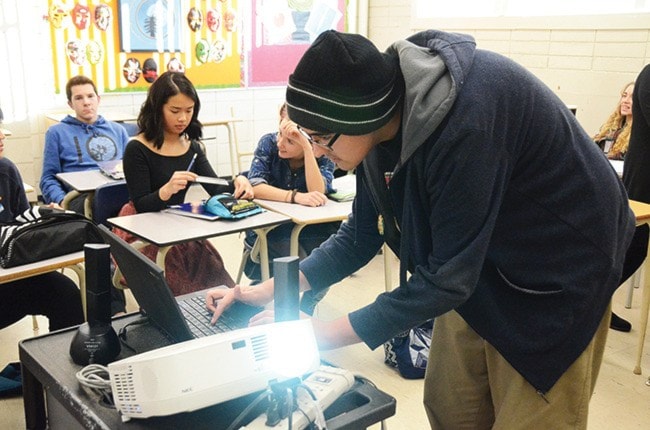Susanna Blakemore’s Psychology 11 class at Carihi isn’t what most people think of when they hear the term.
For most, it’s about how the brain works, and that sounds daunting.
Yes, her class is about, “the study of behaviour and the mind,” Blakemore says, but to her it’s more important to examine the context of that idea – and the context of human behaviour is a pretty broad thing.
Wait – that sounds even more daunting.
And they examine it in as many ways as they can.
“We are always holistic, now,” Blakemore says, her class working independently while she takes a few minutes with a local reporter, rock music pumping in the background as it might on a home stereo system in your living room, “so if there is ever an opportunity for my students – for the persons who come to this class – to experience something in the world, we really just want to facilitate that learning.”
One recent project, for example, began with an email from a university in Monterey, Mexico to the international education coordinator of School District 72, “who threw it open to a number of teachers throughout our district.”
That “it,” Blakemore says, was a group of students in a “Planning 10-type program” down in Monterey, who wanted to speak with students their age in another culture to find out, “who are you and how do you perceive us?” and, “we are interested in looking at addiction and all kinds of chemical intake and dependency within our two cultures and set up a compare/contrast,” Blakemore says.
Blakemore, in all her classes, teaches that, “nothing is anything without the ‘why,’ and this was such a wonderful way to look at the ‘why’ of human behaviour,” she says. “We often, as humans, destroy ourselves or behave in a way that is not for our own good. And it was an important opportunity for my kids to examine the ‘why’ of that.”
So the Carihi students began engaging with the Monterey students through an online resource called Ed Modo, which allowed them to essentially blog back and forth privately over a period of time and discuss these issues.
And then, after all the discussions had taken place, each class made a video about the experience to share with the other side.
Jared Alps, a student in Blakemore’s class who happens to have a knack for videography, took up the cause of creating the video to send to Monterey, and says the whole experience was extremely enlightening.
“I liked it. We actually got to talk to people across the border – two borders, actually,” Alps says. “It was really interesting.”
It surprised him to find that people in a culture so different from our own felt similarly about drugs and addiction, especially considering the stereotypes.
“In general, people seemed to have the same viewpoint when it comes to things like drugs or alcohol. They can be very destructive, and people use them to cope with things like stress or to forget or because they just fall into it and can’t get out. You’d think, because of the reputation of Mexico, that they might look at that differently, but they don’t.”
Fellow student Hannah Dyck agrees.
She didn’t know what to think going in, either, but says she found it enlightening and valuable, as well, especially in breaking those preconceived notions of what life must be like down there.
“I’d never collaborated with international students,” she says, “so it was really nice to get that opportunity, and to break some of those stereotypes.”
She says the fact that they were collaborating directly with other students in another part of the world – rather than, say, reading about their culture in a book or online – made her more engaged with the learning. Which is kind of the point, Blakemore says.
“(Projects like this) open up the pathway into what, for me, is the big question for a student. And that is, in any subject, ‘what is the same as me in the world, and what is different from me in the world?’ And when I find those commonalities, and stand and examine those contrasts, that’s when I can begin to understand the world.”
And that’s become easier in recent years. The world, thanks to technology, is getting smaller, and communication with people is getting easier.
“We can now go, virtually, anywhere on the globe and speak to people about the human behaviour that they observe, process and make meaning of where they are. It’s a wonderful situation to be in as a teacher.
“We can literally ask the world whatever question we want,” she says. “What we need to learn now is to check the integrity of that information, look for veracity and move on to a different kind of inquiry. Now we’re not asking for what or who or where, now we’re inferring from the what, who and where and starting to ask why. That’s a pivot shift in education.”
Why is that shift so important? For Blakemore, it’s a simple concept. Instead of allowing her students to look at the surface facts and memorize them, she wants them to ask more questions. She wants them to go deeper.
“I think it’s fundamental to being able to move beyond the superficiality that is so available,” she says. “We’re so comfortable on the surface. If we tip learners into deeper waters of ‘how’ and why’ and looking at the subtext of being alive so that they will spend time off the superficiality of the surface, they will become great people. They will have an effect in their world and they will find meaning in being alive, and I think that’s the ultimate goal of education.”
It’s not about answering the questions. It’s about the process of asking them. It’s about wanting to keep asking them. And it’s safe to say Blakemore’s students, at least, will continue to do just that.
